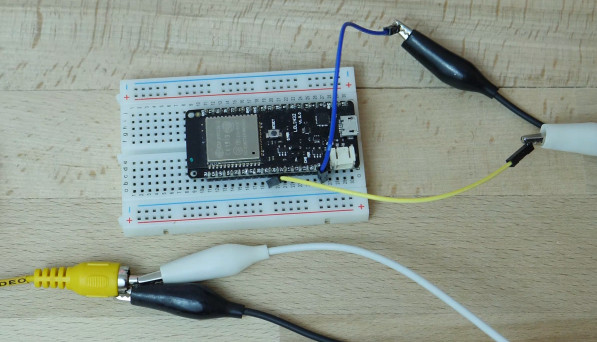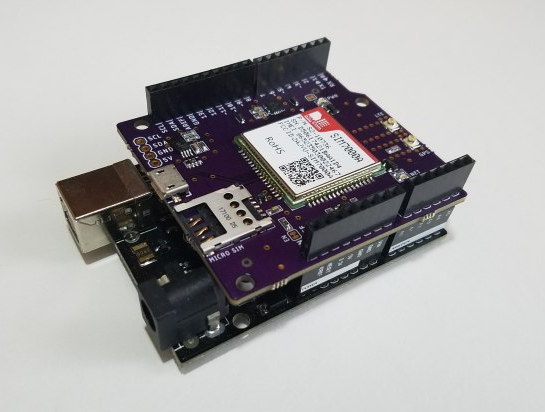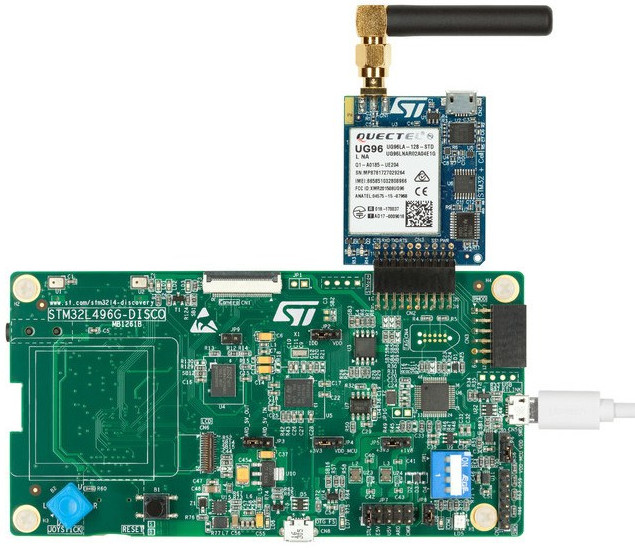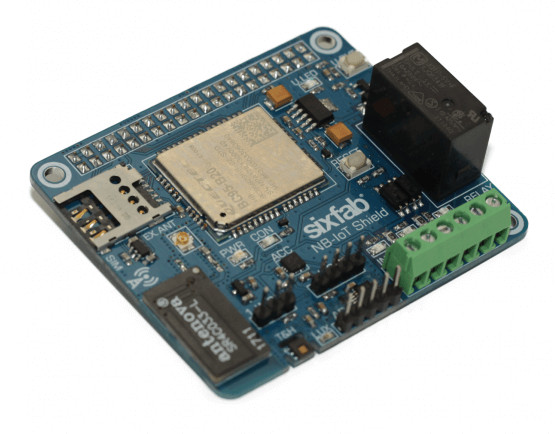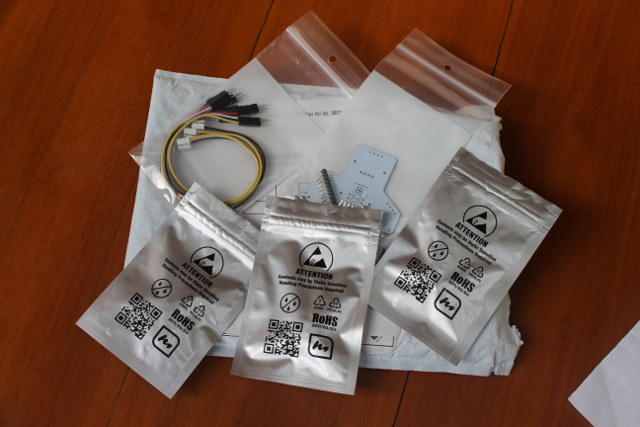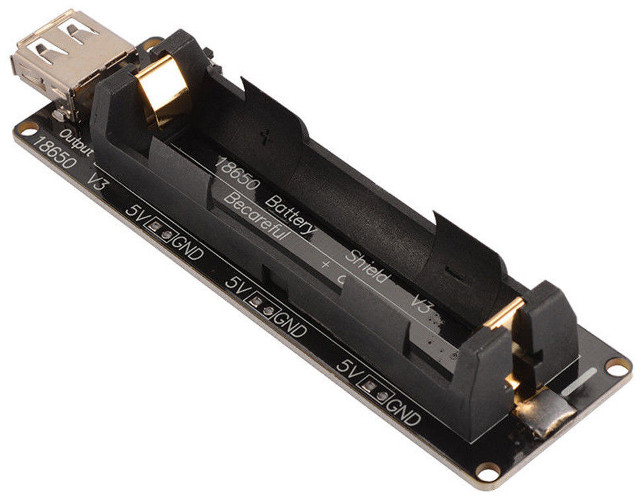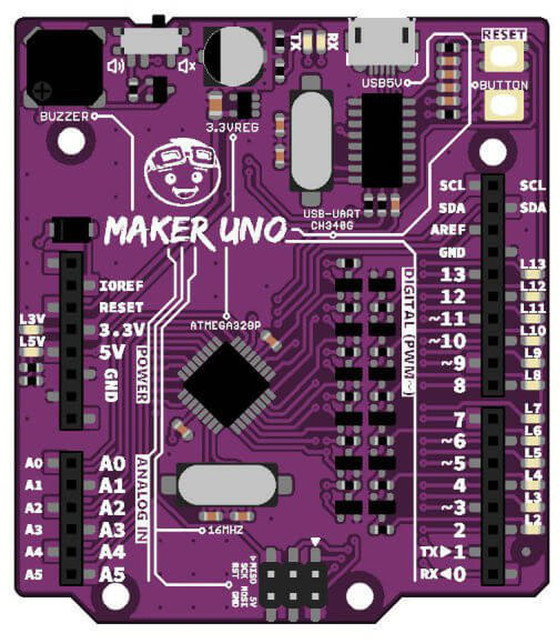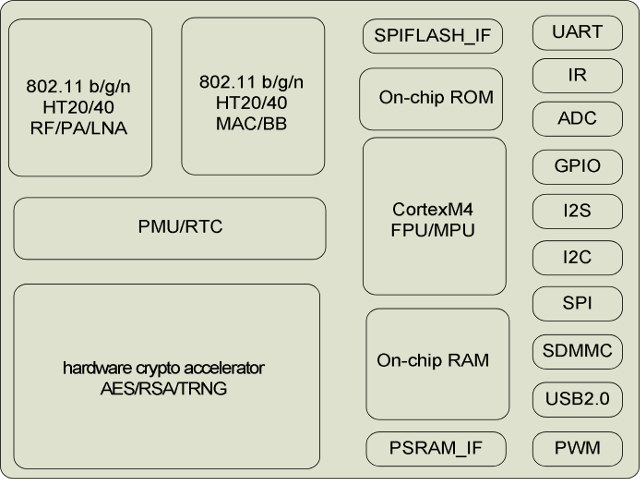A few years ago, we already saw it was possible to transmit color signals over NTSC using an ESP8266 board with the signal received on a TV with an analog tuner. CNLohr had to connect an antenna to the I2S pin of his ESP8266 module, and disable WiFi. But surely we should be able to do the same with ESP32, and potentially even better thanks to the two cores. That’s exactly what Bitluni successfully managed by connecting his LoLin32 board to the composite input of his TV with one handling the TV signal output (in grayscale) and the other core rendering 3D objects in real-time. But any ESP32 board could be use instead. The hardware connection is very easy. We just need two wires, one connected to the GND pin and outer part of the RCA connector, and the other connected to GPIO 25 (DAC1) and the inner part of […]
LTE Cat M and NB-IoT Shield for Arduino Features SIMCom SIM7000-Series Module (Crowdfunding)
We’ve already covered several NB-IoT (and/or LTE Cat M1) Arduino shields with products like RAK Wireless WisLTE, Sixfab Arduino NB-IoT shield, or AIS NB-IoT shield, which all happen to come with Quectel modules. A young self-taught engineer has decided to make his own Arduino eMTC/NB-IoT shield, but based on a SIMCom SIM7000-series module instead of a Quectel one found in the other aforementioned products. Board specifications: Cellular Module (one of the list depending on your location) SIM7000A LTE Cat M1 & NB-IoT module certified for AT&T and Verizon in the US SIM7000C Cat M1/NB-IoT module with 2G/2.5G fallback for the Chinese market SIM7000E Cat M1/NB-IoT module with 2G/2.5G fallback for the European market Note: The developer is also looking into SIM7000G module which should work globally, but the option is not available for now Micro SIM card holder GNSS – GPS/GLONASS with 2.5m accuracy supported by SIMCom modules Antenna – […]
STMicro Introduces Two STM32 Discovery Kits with 2G/3G or 4G LTE-IoT Cat M1/NB1 Connectivity
Embedded World 2018 trade fair will take place on on take place on February 27 – March 1 in Nuremberg, Germany, and we’re starting to see some company announce new products and solutions for the embedded market. STMicro has just announced their showcase their very first cellular development kits at the event, based on a display-less variant on their 32L496GDISCOVERY Discovery board with cellular add-on boards: P-L496G-CELL01 Discovery kit with with a 2G/3G modem P-L496G-CELL02 Discovery kit with with an LTE-IoT Cat M1 (eMTC) / NB1 (NB-IoT) / 2G model Now the company has not started designed their own cellular modem, but instead relying on QUECTEL modems. Both kits share most of the same specifications: MCU – STMicro STM32L496AGI6 Arm Cortex M4F MCU@ 80 MHz with 1 MB Flash, 320 KB RAM in a UFBGA169 package On-board memory – 8 Mbit PSRAM On-board + external storage – 32 KB I2 […]
Sixfab Launches Arduino and Raspberry Pi NB-IoT Shields with Four Sensors
SixFab previously introduced a 3G/4G base shield for the Raspberry Pi boards that would take Quectel based mini PCIe card in order to add cellular connectivity to the popular development boards. The company is now back with NB-IoT shields that should better suited to IoT projects with lower hardware and data costs, and support either 40-pin Raspberry Pi boards or Arduino. SixFab Raspberry Pi NB-IoT Shield Specifications & features: Module – Quectel BC95-B20 NB-IoT Module supporting 800MHz frequency (suitable for the European market) Micro SIM card socket, PCB Antenna and u.FL socket for external antenna I/O expansions 4x Channel 12-bit ADC via ADS1015 Relay with optocoupler protection (24V DC, 120-220V AC Switching) 3-pin 1-Wire interface for DS18B20, DHT21, etc… 4-pin I2C interface 3.3V reference voltage Sensors MMA8452Q 3-axis accelerometer HDC1080 temperature sensor (-40 to +125 °C) HDC1080 humidity sensor (0 to 100%) ALS-PT19 ambient light sensor Misc – User button […]
Getting Started with TinyLIDAR Time-of-Flight Sensor on Arduino and Raspberry Pi
TinyLIDAR is an inexpensive and compact board based on STMicro VL53L0X Time-of-Flight (ToF) ranging sensor that allows you to measure distance up to 2 meters using infrared signals, and with up to 60 Hz. Contrary to most other VL53L0X boards, it also includes an STM32L0 micro-controller that takes care of most of the processing, frees up resource on your host board (e.g. Arduino UNO), and should be easier to control thanks to I2C commands. The project was successfully funded on Indiegogo by close to 600 backers, and the company contacted me to provided a sample of the board, which I have now received, and tested with Arduino (Leonardo), and Raspberry Pi (2). TinyLIDAR Unboxing I was expecting a single board, but instead I received a bubble envelop with five small zipped packages. Opening them up revealed three TinyLIDAR boards, the corresponding Grove to jumper cables, and a bracket PCB for […]
$2 USB “18650 Battery Shield” Powers Arduino, ESP32, and Other Low Power Boards with a 18650 Battery
If you’re looking for battery power for one of your projects, you may consider a “18650 battery shield” – going for just above $2 on Aliexpress or eBay – for powering Arduino boards, Espressif ESP8266 or ESP32 boards, or any board that can be powered by 5V up to 2A via USB or headers, or by 3V up to 1A via headers. Specifications listed on eBay/Aliexpress: Power Input – 5 to 8V via micro USB port up to 0.5A charging Power Output 5V via Type A USB port 3V up to 1A via 3x 2-pin header 5V up to 2A via 3x 2-pin headers Misc – 1 switch control USB output, LED for charging status (green = full, red = charging) Battery protection (Over-charge or Over-discharge) Dimensions – 9.8 x 2.9 cm You’ll need to add your own 18650 battery, and be careful about polarity while installing it, since putting […]
$6 Maker UNO Arduino UNO Clone Comes with Micro USB Power, I/O LEDs, and a Buzzer
Arduino UNO is one of the older Arduino boards, but also one of the most popular, and there are already many clones, which you can buy for as low as $3 shipped. But Malaysian based Cytron Technologies has decided to make their own Arduino UNO Compatible board, designed specially for students to learn coding and microcontroller, that brings some tweaks to the original design. First, they’ve done away with the power jack, and instead went with a more convenient micro USB port for power. They also added an LED for each digital I/O, so students can easily see I/O activity, and finally included a piezo buzzer to play sounds or melodies, as well as a push button. Maker UNO specifications with differences highlighted in bold: MCU – Microchip Atmel ATMega328P AVR micro-controller @ 16 MHz with 32KB flash, 2KB SRAM, 1KB EEPROM I/Os 14x digital I/Os including 6x PWM 6x […]
$1 RDA5981 WiFi IoT Arm Cortex-M4 SoC is Designed for Smart Home Devices, Smart Speakers
RDA Microelectronics processors are found in a few cheap smart and not-so-smart phones, as well as the even cheaper Orange Pi i96 board. But the company does not only design cellular chips, but their portfolio also includes solutions for the Internet of Things and TV & radio tuners. RDA5981 is a WiFi IoT chip specifically designed for smart home & audio application, such as smart speakers, and it’s found in devices running Baidu DuerOS, the Chinese equivalent of Amazon Alexa or Google Assistant. The company explains it can be widely used in televisions, set-top boxes, smart appliances, wireless monitors, and other products. RDA5981 A/B/C processor specifications: CPU – Arm Cortex-M4 @ up to 160 MHz with integrated MPU and mbed uvisor System Memory – Up to 448 KB SRAM for network stack and application, external PSRAM interface Storage – Up to 32Mbit SPI flash Connectivity WiFi 2.4 Ghz 802.11b/g/n WiFi […]


